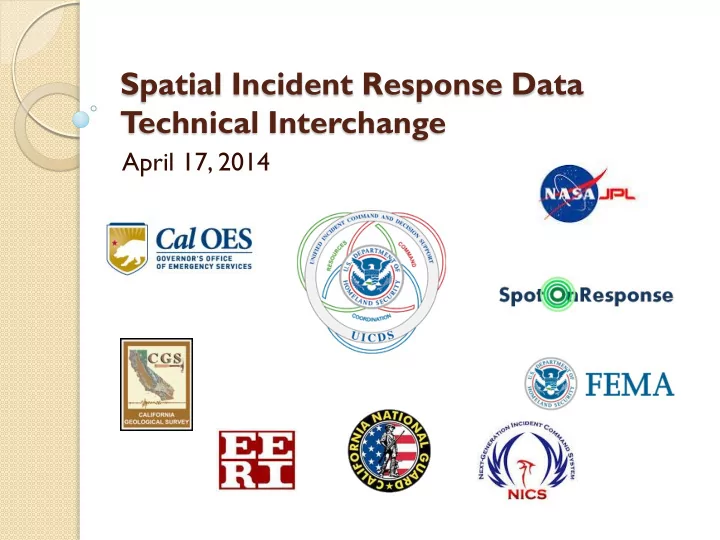

Spatial Incident Response Data T echnical Interchange April 17, 2014
What We Do All emergencies are local where the role is to respond to observed impacts and identified threats with resources that protect people, property, and the environment from loss. The role of the state is to coordinate and facilitate multi-agency and multijurisdictional emergencies in California, facilitate the flow of information within and between levels of the system, and facilitate coordination among all responding agencies. The federal role is to coordinate federal, military, and multi-state/regional resources in support of state needs.
How We All Operate To respond requires field information on about impacts and threats and their actual impact on people, property, and the environment from sensors and human sensors. The state coordinates requests for resources from the local, regional, state, and federal levels though mission tasking prioritized by life safety, property and the environment To coordinate an operation requires situational awareness, a common operating pictures, and forecast models that forecast as yet unobserved impacts.
Standardized Emergency Management System The Standardized Emergency Management System (SEMS) was established to provide effective management of multi-agency and multi-jurisdictional emergencies in California. SEMS is the cornerstone of California’s emergency response system and the fundamental structure for the response phase of emergency management in California Local governments must use SEMS to be eligible for funding of their response-related personnel costs under state disaster assistance programs.
Standardized Emergency Management System SEMS consists of five organizational levels, which are activated as necessary: 1. field response 2. local government 3. operational area (county) Operational Area Local Unaffected Government Incident Local Command Government System ICP Resources Incident
Standardized Emergency Management System 3. operational area (county) 4. regional State 5. state (SOC) Region Operational (REOC) Operational Areas Resources Area Resources Requests Resources Requests Requests Unaffected Unaffected Local Local Local Government Government Government Major Resources Disaster Resources
National Incident Management System Federal resources become available after a disaster declaration or emergency management declaration is made by the president, in response to a Request for Federal Declaration by the state governor. Federal State Resources Requests Region Operational Operational Areas Resources Area Resources Requests Requests Unaffected Local Unaffected Local Government Government Local Government Major Resources Disaster Resources
What We Need to Know to Respond, Facilitate, and Coordinate What is it? Incident management means coordinating among multiple agencies Where is it? The geospatial view showing hazard and people, infrastructure, environment Who’s in charge? Organizing incident command or emergency support function Who should know? Alerts from authoritative sources, who has received alert, who has responded What’s the impact? Understanding the environment by sharing sensors, cameras, imagery, models What is the response? Resources employed, operating procedures followed, tasks performed What’s happening now? Situational awareness, common operating picture, shift change briefing, statistics What’s planned next? Action plans, future resource allocation and tactical response, forecast of impacts
Why We Are Involved T oday At all levels of en emergency, different information is generated and the technologies to support that are varied. They are designed to meet the needs of their users. Information, Field Observations, Incident Geospatial Information, all have a specific purpose, and that is what makes them so good for their users. As a result, when individual agencies need to coordinate with others, we have challenges distinguishing what information is pertinent to each role or agency. The challenge is to make sure authoritative information is captured and used at the appropriate level , and that it is managed in an organized way.
The UICDS Advantage The advantage of the UICDS technology is to be able to control the information flow, and have access to any relevant data from multiple sources. At the State and Federal level, different roles have been established using the Emergency Functions (EFs) and Emergency Support Functions (ESFs) UICDS can be the bridge over the divide between the multiple technologies and viewers to provide interoperability , and focus on the Common Operational Data that supports management by objectives and smart decision making
The Basics of Geospatial Information Fill a Polygon – lake, area, building, field Transparency – allows overlays like chemical plume Make icons for points The combination of points, lines, polygons, fills, imagery and transparency makes a map that is useful
The Basics of Emergency Information Field Observations Logs Checklists Sensor Readings Inventory Field Photos Diagrams and Videos Situation Documents Reports Plans
Filling the Interoperability Gap with Common Operational Data To Respond, Facilitate and Coordinate Respond Facilitate Common Operational Data Coordinate
CalOES T echnology Choices Interoperability With Other Technologies UICDS/Keystone Interoperability Middleware UICDS Core WebEOC Metadata ArcGIS Online Digest Data Fractional Data
FEMA T echnology Choices UICDS Core Metadata Digest Data WebEOC ArcGIS Online Fractional Data UICDS/Keystone Interoperability Middleware ICDS Interoperability With Other States
How This Works Demonstration
Recommend
More recommend